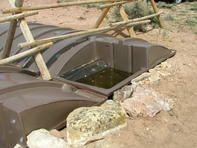Rainwater harvesting is the channelling and storing of rainwater from the earth or the roofs of buildings via pipes or gutters to a water storage tank. Collecting rainwater from roofs is much cleaner than collecting runoff water from the earth.

In either case, cleaning and filtering the rainwater before use is recommended. Not only does it clean the water for domestic or agricultural use, but it will also remove chemicals, soil and contaminants and will prevent pumps being damaged due to objects in the water.
How to Set up a Rainwater Harvesting System
To set up a simple rainwater harvesting system requires three things; a roof, pipes or gutters, to channel the rainwater, and a storage tank.
Clean the roof and the gutters. If gutters or pipes need to be installed, choose good quality UV-resistant PVC gutters and downpipes. Make sure the downpipes are connected to the water tank. Ensure the gutters slope slightly towards the tanks. This will eliminate the accumulation of sludge and stagnant water, becoming a breeding ground for mosquitoes.
Any branches hanging over the roof should be removed to prevent leaves entering the system. Use mesh screens or filters and clean them regularly.
Chemical drift from spraying can land on the roof and then be washed into the tank. Do not spray crops on a windy day.
When painting the roof, use a safe paint as paint residues may leach into the tank and contaminate the water.
Clean the roof after any fires in the area. After rains, ash and debris may be washed into the tank, thereby clogging the taps. Remember, the cleaner the roof, the cleaner the water.
A filtering system to clean the water before use may be needed and can be in the form of:
Sandbed filter
Pop-up filter
Stabilisation tank
Water Storage Tanks

Any water storage tank can be used, but ensure it is clean and has an outlet or a tap. Install a large enough tank and, if possible, put it on a strong and level base, high enough to allow buckets to be easily filled from the tank’s tap. If building a concrete base, make sure it is at least 85 mm thick.
Do not use a tank that was previously used for storing anything poisonous such as fuel, oil or chemicals. If possible, do not use a tank made from asbestos. Water tanks can be made out of polyethylene plastic, concrete or galvanised zinc. Metal tanks should be coated on the inside with food-grade liners like PVC or polyethylene. Plastic water tanks are cheaper, while concrete tanks may be expensive but they do keep the water cool.
Consider installing an overflow tank to store excess water once the primary tank reaches a specific level. If using tank water as drinking water, make sure to boil it first. It should also be filtered and treated with bleach. The Water Research Commission’s researchers recommend a ¼ cup of bleach per 5 000 litres of water.
Keep a lock on the tank’s the tap to prevent access to the water tank. Prevent anyone from climbing onto the tank, accidentally falling in and drowning.
Source Water Research Commission